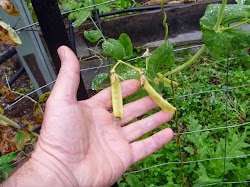Post by templeton on Apr 13, 2015 2:02:41 GMT -5
Thought I would start a separate thread to avoid confusion.
Today I planted 5 F1 seeds of my redesigned red podded snowpea project.
Originally I did some crosses of purple podded soup peas with Golden podded, an indifferent yellow snow. My plan was to get a red podded, fibrous or not, and then cross it back to get snows if needed. Since this required more room than my other yellow and purple podded projects would allow, I got some F1s but was pretty undisciplined about growing them out - only junk seed that had got wet by accident got planted, then it was mass collected, and anything with colour was grown out under my espalier apricots - there was nowhere else to plant them, and i wasn't too serious about the assessment.
I've decided to change tack, and start anew, enlightened by my experience developing yellow and purple snows.These new F1s are a cross between two of my developing lines which are around F5-6, Joni's Taxi and Pixie Moon, sibling big yellow podded snowpeas derived from Yakumo (I can't remember exactly which sibling I used), and Heather, a tall purple podded snowpea, also out of Yakumo. Both of the parents are relatively stable for the main characteristics. I'm looking for a tall, big podded red snowpea. I'll be growing out the F1s in a greenhouse over our relatively mild winter, hoping for F2 seed for SH spring 2015.
Big pods, tall, and no fiber should be locked in, since all the parents have these characteristics.
In the F2, 1/4 should have yellow, 3/4 should have A, 3/4 Pu, and 3/4 Pur, the three purple genes. that's a 27/256 chance that any F2 will have these characteristics, or around 1 in 10. But even one of either Pu or Pur will still give delightfully blushed pods, so the chances of something nice turning up in my short row that has room for around 40 plants should be good.
Since all the purple genes (A, Pu, Pur) are all dominant, it will take a few generations to stabilise, but if I sow subsequent generations plant-to-row, with about 6 seeds per parent, it's relatively easy to find the homozygous parents in the population - if they exist.


Today I planted 5 F1 seeds of my redesigned red podded snowpea project.
Originally I did some crosses of purple podded soup peas with Golden podded, an indifferent yellow snow. My plan was to get a red podded, fibrous or not, and then cross it back to get snows if needed. Since this required more room than my other yellow and purple podded projects would allow, I got some F1s but was pretty undisciplined about growing them out - only junk seed that had got wet by accident got planted, then it was mass collected, and anything with colour was grown out under my espalier apricots - there was nowhere else to plant them, and i wasn't too serious about the assessment.
I've decided to change tack, and start anew, enlightened by my experience developing yellow and purple snows.These new F1s are a cross between two of my developing lines which are around F5-6, Joni's Taxi and Pixie Moon, sibling big yellow podded snowpeas derived from Yakumo (I can't remember exactly which sibling I used), and Heather, a tall purple podded snowpea, also out of Yakumo. Both of the parents are relatively stable for the main characteristics. I'm looking for a tall, big podded red snowpea. I'll be growing out the F1s in a greenhouse over our relatively mild winter, hoping for F2 seed for SH spring 2015.
Big pods, tall, and no fiber should be locked in, since all the parents have these characteristics.
In the F2, 1/4 should have yellow, 3/4 should have A, 3/4 Pu, and 3/4 Pur, the three purple genes. that's a 27/256 chance that any F2 will have these characteristics, or around 1 in 10. But even one of either Pu or Pur will still give delightfully blushed pods, so the chances of something nice turning up in my short row that has room for around 40 plants should be good.
Since all the purple genes (A, Pu, Pur) are all dominant, it will take a few generations to stabilise, but if I sow subsequent generations plant-to-row, with about 6 seeds per parent, it's relatively easy to find the homozygous parents in the population - if they exist.

